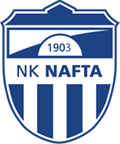
Nogometni klub Nafta Lendava, commonly referred to as NK Nafta Lendava or simply Nafta, was a Slovenian football club, which played in the town of Lendava. They were founded as Lendvai Football Egyesület in 1903 during Hungarian administration. They were regarded as the oldest Slovenian football club until they filled for bankruptcy and were dissolved following the 2011–12 Slovenian PrvaLiga season. The club played in the Yugoslav First League for one season, in 1946–47.

Zala was an administrative county (comitatus) of the Kingdom of Hungary. Its territory is now in southwestern Hungary, northern Croatia and eastern Slovenia. The territory of the county comprised what is now the Hungarian county Zala and part of Veszprém county, the Croatian region of Međimurje to the south-west of it, bordered by the river Drave, and a small region around Lendava in Slovenia. The capital of the county was Zalaegerszeg.

Slovenia has been a meeting area of the Slavic, Germanic, Romance, and Uralic linguistic and cultural regions, which makes it the most complex meeting point of languages in Europe. The official and national language of Slovenia is Slovene, which is spoken by a large majority of the population. It is also known, in English, as Slovenian. Two minority languages, namely Hungarian and Italian, are recognised as co-official languages and accordingly protected in their residential municipalities. Other significant languages are Croatian and its variants and Serbian, spoken by most immigrants from former Yugoslavia and their descendants. Slovenia is ranked among the top European countries regarding the knowledge of foreign languages. The most often taught foreign languages are English and German, followed by Italian, French, and Spanish.

Benica is a small settlement in the Municipality of Lendava in the Prekmurje region of Slovenia. It lies close to the extreme eastern tip of Slovenia, near the Mura River on the right bank of the Ardova Canal, close to the borders with Croatia and Hungary. Until the canal was built in 1910, the area occupied by the settlement was part of the Mura Woods, but then the area was cleared and in 1923 the Esterházy family's manorial possessions were taken away and transferred to settlers who were refugees from the Isonzo Front. Until the Second World War it was a hamlet of Pince.

Dolgovaške Gorice is a settlement in the hills east of Lendava in the Prekmurje region of Slovenia. It lies on the border with Hungary.

Dolnji Lakoš is a village southwest of Lendava in the Prekmurje region of Slovenia.

Čentiba is a settlement southeast of Lendava in the Prekmurje region of Slovenia, close to the border with Hungary.

Genterovci is a settlement north of Lendava in the Prekmurje region of Slovenia. It lies on the border with Hungary.

Gornji Lakoš is a village southwest of Lendava in the Prekmurje region of Slovenia.

Kamovci is a small village on the road from Dobrovnik to Lendava in the Prekmurje region of Slovenia, right on the border with Hungary.

Kapca is a village west of Lendava in the Prekmurje region of Slovenia.

Kot is a small village south of Kapca in the Municipality of Lendava in the Prekmurje region of Slovenia. It lies on the left bank of the Mura River, on the border with Croatia.

Mostje is a settlement north of Lendava in the Prekmurje region of Slovenia, on the border with Hungary.

Petišovci is a settlement south of Lendava in the Prekmurje region of Slovenia. It lies on the left bank of the Mura River, right on the border with Croatia.

Pince–Marof is a settlement southeast of Lendava in the Prekmurje region of Slovenia. It lies close to the border with Hungary and its territory extends to the extreme eastern point of Slovenia.

Radmožanci is a settlement northwest of Lendava in the Prekmurje region of Slovenia.

The 2012 UEFA European Under-17 Championship was the eleventh edition of UEFA's European Under-17 Football Championship under its current age grouping. Slovenia hosted the tournament between 4 and 16 May. An appeal by the Hungarian Football Federation to have Hungary replace Belgium over an ineligible player in the Belgium V Russia elite round match was unsuccessful.

European route E 653 is a European B class road in Hungary and Slovenia, connecting the cities Letenye – Maribor.













